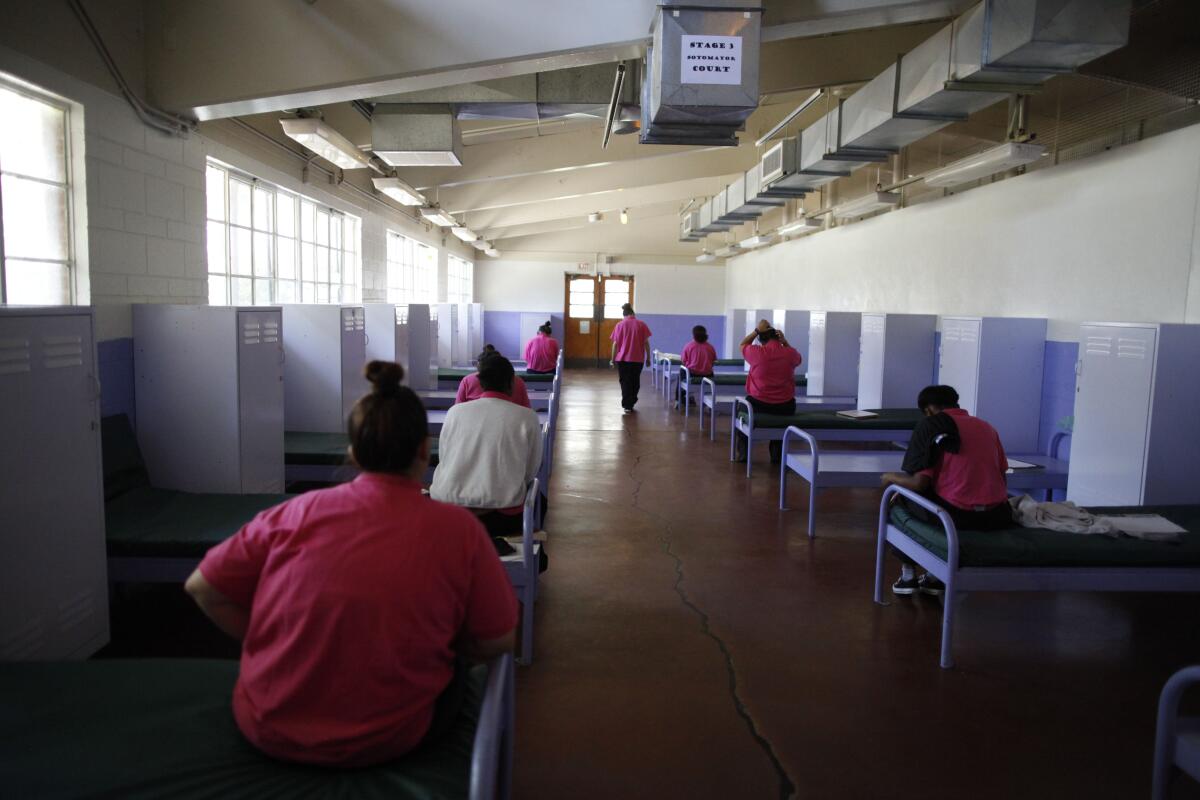Reams of documents related to L.A. County sex abuse cases never turned over, lawyers say

- Share via
Thousands of documents that could contain key details about rampant childhood sexual abuse inside a defunct Santa Clarita detention camp — including so-called “grooming drawings” — were left scattered inside the facility and never turned over to the victims’ attorneys, according to a firm suing L.A. County over the decades-old incidents.
As part of the preparation for a looming June trial, attorneys with law firm Manly, Stewart & Finaldi had arranged April 15 to visit Camp Scott, a shuttered L.A. County probation camp where many of their clients say they were sexually abused as children.
Inside the facility were reams of records that the county should have turned over to the firm more than a year ago through discovery, said attorney Courtney Thom, whose firm has about 150 civil cases alleging sexual abuse by county probation staff.
“You can understand my shock when I’m walking through where my clients got raped as children, and there are documents everywhere,” Thom said at a Monday superior court hearing in downtown Los Angeles.
Thom said she discovered thousands of paper grievances, a locked file cabinet labeled “Personnel Files CAMPS A – W,” and a drawing she believed was signed by Thomas Jackson — a probation deputy accused by at least 20 women of sexually assaulting them at the camp.
The drawing, included in a court filing, was of the name “TAMI” in big, block orange letters and appeared to be signed by a “Jackson. T.”
Attorney James Sargent, who is representing the county and accompanied Thom for the tour last week, called her claims “inflammatory and incorrect.”
“They want to air what they deem as dirty laundry,” said Sargent, who told L.A. Superior Court Judge Lawrence Riff that the personnel files they discovered had nothing to do with the staff named in the lawsuits.
Nor did the drawing, he said. Tami Wilson, a former supervisor at the camp, told him she recalled being given the hand-drawn card by a youth, he wrote in a court filing.
The county announced earlier this month they planned to pay $4 billion to settle nearly 7,000 claims of alleged sexual abuse inside the county’s juvenile facilities and foster homes. The settlement — believed to be the largest sex abuse settlement in U.S. history — arose from Assembly Bill 218, a 2020 state law that gave victims of childhood sexual abuse a new window to file civil suits against alleged predators and the agencies that employed them.
A handful of prominent firms — including Manly, Stewart & Finaldi — declined to participate in the settlement and have ongoing litigation.
In the aftermath of AB 218, state legislators have introduced several bills to attempt to make it easier for governments and school districts to deal with the financial fallout from the deluge of suits.
One of these bills — SB 577 — is set for a hearing Tuesday. The bill’s author, State Sen. John Laird, said the legislation is intended to “restore some equilibrium,” lessening the financial blow to public agencies while still upholding a victim’s right to sue.
County lawyers claim one reason the state law change has had such a devastating financial toll is because many of the records they need to fight decades-old cases are long gone. Attorney John Manly argued the claim flew in the face of what his firm saw at Camp Scott.
The county “has been telling all of Sacramento that they don’t have any documents,” said Manly, who urged the judge to allow his firm to publicize the footage they’d taken of the heaps of documents. “We need to be able to share this with legislators.”
Riff agreed with the county’s request that the videos from inside Camp Scott remain confidential for now due to security risks, though he instructed both sides to try to find some common ground on whether certain videos could be made public. Though Camp Scott hasn’t been used to house youths for years, Sargent wrote in a filing that may soon change.
L.A. County Superior Court Judge Miguel Espinoza ordered the county Friday to prepare to shut down Los Padrinos Juvenile Hall — the county’s last remaining juvenile hall, where roughly 270 youths are held — due to problems stemming from chronic understaffing.
“The youth presently in Los Padrinos will need to go somewhere, and if some wind up at Camp Scott, the public release of photos and videos could be seriously detrimental,” Sargent wrote.
Thom noted that both reporters and television crews have been allowed to broadcast footage taken inside the camp, including a 2001 documentary, “Camp Scott Lock-Up.”
“The L.A. Times has been in there to photograph,” said Thom. “MTV videoed more than we did.”
More to Read
Sign up for Essential California
The most important California stories and recommendations in your inbox every morning.
You may occasionally receive promotional content from the Los Angeles Times.











